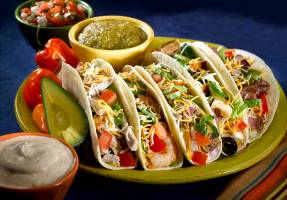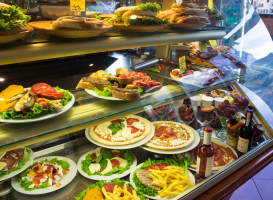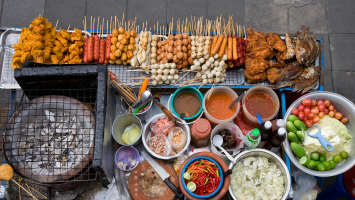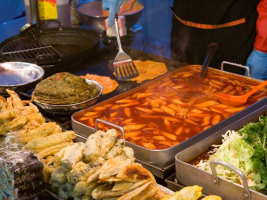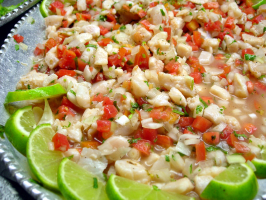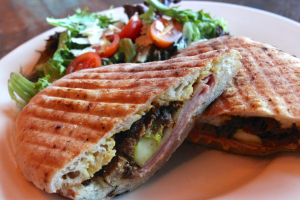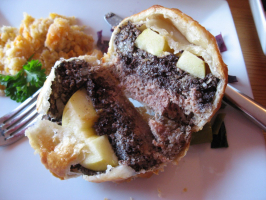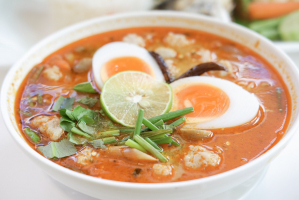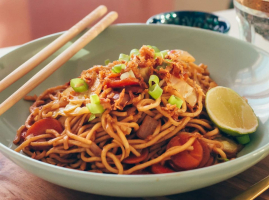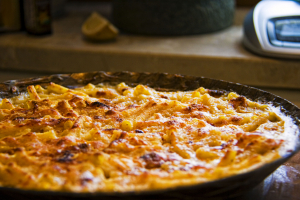Top 12 Best Street Food in Budapest
Budapest is famous not only for its beautiful architecture and rich history, but also for its delicious street food scene. Join us on a culinary adventure ... read more...explore the top 12 best street food in Budapest.
-
Goulash is a hearty and flavorful stew embodying Hungarian cuisine's essence. It is often regarded as Hungary's national dish. Its origins can be traced back to the 9th-century Magyar shepherds, who devised a simple yet nourishing meal to sustain them during their long journeys across the vast Hungarian plains.
At its core, goulash is a delicious fusion of tender meat, typically beef or veal. It is slow-cooked with aromatic ingredients and seasoned with a generous blend of paprika. This spice has become synonymous with Hungarian cuisine. The use of paprika gives the stew its distinctive and vibrant red hue, infusing it with a smoky, mildly spicy flavor that is both comforting and satisfying.
While the modern version of goulash has evolved over the centuries, it still pays homage to its humble beginnings. Traditional goulash features large chunks of meat, such as shoulder or shin, which are seared to seal in their juices before being simmered in a savory broth.
Goulash's versatility is one of its most appealing attributes. Variations have emerged, incorporating different meats such as pork or lamb and offering vegetarian versions with mushrooms or beans. This iconic dish offers a delicious meal and a journey through history, showcasing the enduring appeal of a timeless recipe.
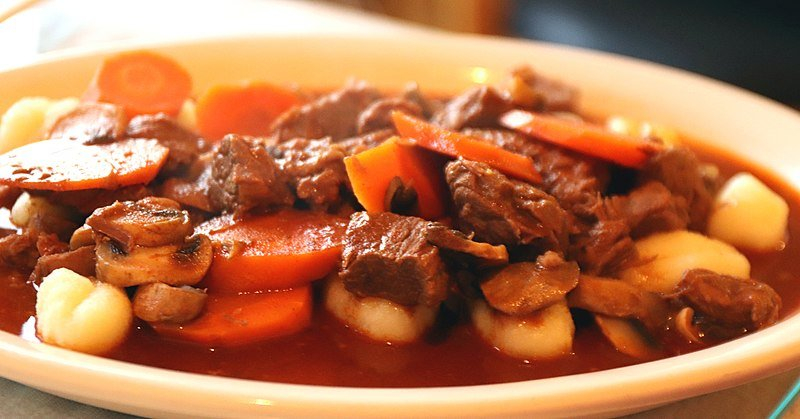
Screenshot of https://commons.wikimedia.org/wiki/File:Goulash_~_Savory_beef_stew_with_mushrooms_and_carrots_%2844301070064%29.jpg Video by RecipeTin Eats -
Chimney cake, also known as Kürtskalács or Trdelník, is a beloved pastry that has captured the hearts and taste buds of people around the world. Chimney cakes are known for their distinctive spiral shape, resembling a chimney or a hollow cylinder. The dough is wrapped around a wooden or metal rod and roasted over an open flame or baked, creating a mesmerizing visual and sensory experience. This unique presentation is an instant attention-grabber.
Chimney cakes can be customized with a variety of flavors and fillings. Whether it's classic cinnamon and sugar, chocolate, nuts, or even savory options, the versatility of chimney cakes caters to a wide range of tastes. Chimney cakes are often enjoyed hot off the grill, providing warmth and comfort on chilly days.
Chimney cakes have gained popularity around the world. Their presence at festivals, fairs, and local markets in various countries showcases their universal appeal. The visually striking appearance of chimney cakes makes them a favorite for social media enthusiasts. Their photogenic qualities make them an Instagram-worthy delight.
Chimney cakes are frequently sold as street food, adding to their charm. The experience of buying one from a vendor, watching it being prepared, and savoring it while exploring a new place adds to the overall enjoyment. Chimney cakes hold a special place in the world of sweets, making them a beloved treat that continues to captivate customers of all ages and backgrounds.
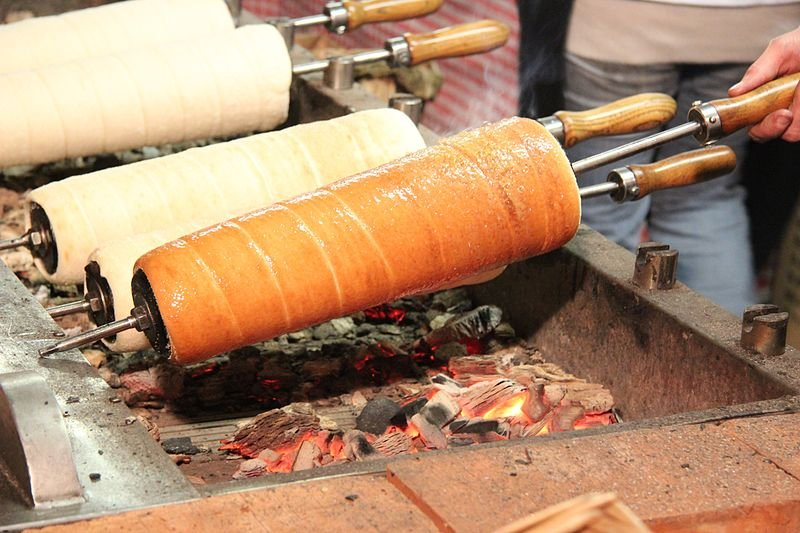
Screenshot of https://commons.wikimedia.org/wiki/File:Budapest-Baumkuchen_6363.jpg Video by Jamie Geller -
Kolbasz, a savory and flavorful sausage dish, has a rich history of formation and development with roots in Central Europe, particularly Hungary. Its journey from humble beginnings to a beloved culinary tradition is a testament to the region's cultural and culinary evolution.
The origins of kolbasz can be traced back to the Hungarian and Central European traditions of sausage-making, which date back centuries. Early versions of kolbasz were simple, rustic sausages made by Hungarian farmers and butchers, often utilizing the available meats, spices, and preserving methods.
Kolbasz's development took a significant turn during the 18th and 19th centuries when the dish made its way to the bustling streets of Budapest and other Hungarian cities. Street vendors began grilling and serving kolbasz to hungry urban dwellers, marking the emergence of this dish as a street food classic. The 20th century brought further refinement and commercialization of kolbasz production.
Today, kolbasz has achieved international recognition, appreciated for its bold flavors and versatility. It is enjoyed not only in Hungary but also in countries around the world, making it a global ambassador of Central European cuisine. Kolbasz's history of formation and development is a story of how a simple regional dish can evolve into a culinary treasure cherished by food enthusiasts of all backgrounds.

Screenshot of https://commons.wikimedia.org/wiki/File:Magyar_kolb%C3%A1sz.jpg Video by Urban Treats -
Paprikas Csirke features tender chicken cooked in a creamy paprika-laden sauce. The generous use of Hungarian paprika imparts a deep, smoky, and slightly spicy flavor, creating a rich and hearty taste that is both comforting and satisfying. The dish is a reflection of Hungary's culinary traditions and cultural identity. It is a source of national pride and showcases the use of paprika, a quintessential Hungarian spice.
Paprikas Csirke can be adapted to various preferences, using different cuts of chicken or even replacing chicken with other proteins like pork or mushrooms. This adaptability allows for personalization and ensures its appeal to various tastes. The velvety, creamy sauce in Paprikas Csirke adds a luscious and indulgent quality.
This dish epitomizes comfort food, offering warmth and nostalgia with every bite. It is particularly popular during the colder months in Hungary, providing both physical and emotional comfort. Paprikas Csirke is relatively easy to prepare, making it accessible to home cooks of various skill levels. Its simplicity doesn't compromise on taste, which adds to its universal appeal.
The vibrant red hue of the paprika-infused sauce, often contrasted with the white of the sour cream, creates an aesthetically pleasing presentation. The visual appeal of the dish complements its delicious taste. Paprikas Csirke's enduring appeal lies in its cultural significance, rich flavors, creamy texture, adaptability, and comforting nature.
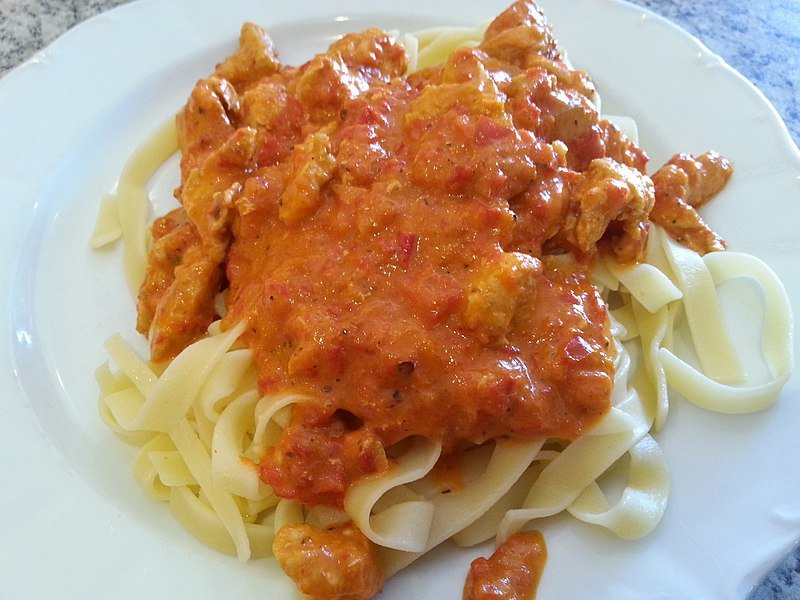
Screenshot of https://commons.wikimedia.org/wiki/File:Paprik%C3%A1s_Csirke.jpg Video by Andi’s kitchen -
The next position in the top 12 best street foods in Budapest is Toltott Kaposzta. It is also known as Hungarian stuffed cabbage, a classic Hungarian dish renowned for its hearty and comforting flavors. It is a staple of Hungarian cuisine, particularly during the winter months and festive occasions.
There are several regional and personal variations of Töltött Káposzta. Still, the fundamental concept involves wrapping ground meat and rice in blanched cabbage leaves and simmering them in a flavorful tomato-based sauce. Here are some common types of Töltött Káposzta:This is the most basic and widely recognized version. Cabbage leaves are parboiled and then filled with ground pork or beef, rice, onions, and various seasonings. The stuffed cabbage rolls are simmered in a rich tomato sauce with paprika, creating a savory and slightly sweet dish. The filling typically includes rice, mushrooms, onions, and various spices in this meatless variation.
This version incorporates sauerkraut, which adds a tangy flavor to the dish. The filling remains similar to the traditional recipe, but the sauerkraut enhances the overall taste profile. Some variations include smoked meats like smoked sausages, bacon, or ham in the filling mixture. The smoky flavors infuse the cabbage rolls with a distinctive taste.
Instead of rolling individual cabbage leaves, the ingredients are layered in a casserole dish, making it easier to prepare and serve. The flavors remain the same, but the presentation is different. Töltött Káposzta is often served with a dollop of sour cream and crusty bread, creating a satisfying and wholesome meal.
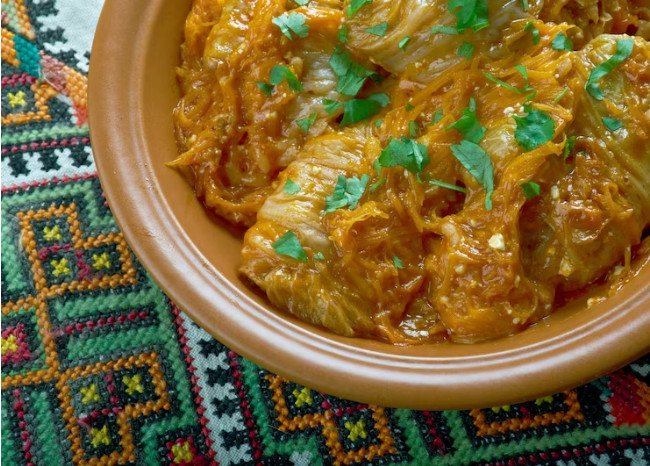
Screenshot of https://www.freepik.com/premium-photo/toltott-kaposzta-hungarian-stuffed-cabbage_15912607.htm Video by Recept Videók -
Túrós Csusza, whose name translates to "cheese pasta" in English, is a harmonious blend of simple ingredients that results in a rich and comforting meal. Túrós Csusza has two main components: pasta and túró, a type of Hungarian curd cheese that's similar to cottage cheese. The pasta used can vary but is typically wide egg noodles or small square-shaped pasta called "csusza.
The star of Túrós Csusza is the cheese sauce with sour cream, resulting in a rich, tangy, and velvety texture. This mixture is then seasoned with salt and pepper and sometimes a touch of garlic for added depth of flavor. Some dish variations may also include crispy bacon bits or caramelized onions for a savory kick. After cooking, the pasta is generously coated with the creamy cheese sauce, creating a luscious and satisfying combination.
Túrós Csusza is a popular comfort food in Hungary and is often enjoyed during family gatherings, celebrations or as a hearty meal on a cold day. This comforting dish balances textures and flavors, with the soft and creamy cheese sauce melding seamlessly with the tender pasta.
Túrós Csusza is a delicious meal representing the Hungarian culinary tradition passed down through generations. It serves as a reminder that comfort food can bridge the gap between nostalgia and the warmth of the present, offering a taste of home and tradition with every indulgent bite.
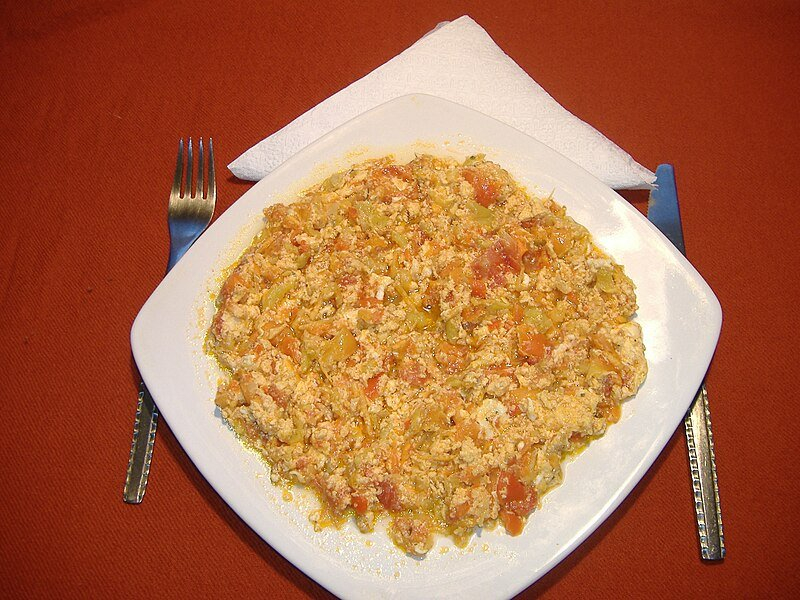
Screenshot of https://commons.wikimedia.org/wiki/File:Lecs%C3%B3.JPG Video by qkatie -
Fozelek offers tourists a distinctive taste of Hungarian cuisine. Fozelek primarily comprises fresh, seasonal vegetables, showcasing the importance of quality ingredients in Hungarian cooking. This emphasis on fresh produce appeals to tourists seeking healthy and natural dining options. The combination of vegetables, spices, and the creamy roux or sour cream-based sauce creates a burst of both comforting and satisfying flavors.
Fozelek comes in a wide range of flavors and ingredients, from the classic spinach or peas to more exotic options like squash or nettle. This variety ensures that tourists can find a Fozelek that suits their taste preferences. Hungary has a rich tradition of vegetarian cuisine, and Fozelek is a perfect representation of this.
Trying Fozelek provides tourists with a direct link to Hungarian culture and traditions. It's a reminder that food is a significant aspect of any culture, and sharing a meal is a way to connect with locals and their way of life.
The vibrant colors of Fozelek, with its assorted vegetables and colorful sauces, make it visually appealing and Instagram-worthy. Tourists often share their Fozelek experiences on social media, spreading the word about this delightful dish. Fozelek is not only delicious but also budget-friendly.Fozelek is readily available in Hungarian restaurants, particularly in Budapest and other tourist destinations. Its accessibility makes it a convenient choice for travelers exploring the country.
Enjoying Fozelek is not just a meal; it's a memorable experience. Tourists often associate their time in Hungary with the local restaurants' delightful flavors and welcoming atmosphere where they savor this traditional dish.

Screenshot of https://www.mindmegette.hu/a-legfinomabb-sargaborso-fozekek.recept/ Video by Mindmegette.hu -
Flodni, a delectable dessert originating from the Hungarian-Jewish culinary tradition, has undergone a fascinating evolution on the streets of Budapest. This multilayered pastry, which traditionally graced holiday tables, has now become a beloved street food delight.
Historically, Flodni was a specialty reserved for festive occasions and was meticulously prepared in Jewish homes. Its distinctive layers include poppy seeds, walnuts, apples, and plum jam, all held together within a flaky pastry crust. Each layer represented a symbolic element, reflecting the diverse cultural influences in Hungary.
The evolution of Flodni on the streets of Budapest can be attributed to its adaptation to the fast-paced urban lifestyle. Street vendors and bakeries began to offer individual slices or mini Flodni pastries, making them accessible to people on the go. This shift in presentation allowed locals and tourists to experience the rich flavors and cultural significance of Flodni without the need for a formal holiday feast.
Today, you can find Flodni slices in the bustling markets, outdoor festivals, and quaint pastry shops across Budapest. Modern variations also include Flodni ice cream, cakes, and even cocktails, showcasing the dessert's adaptability and appeal to a broader audience.
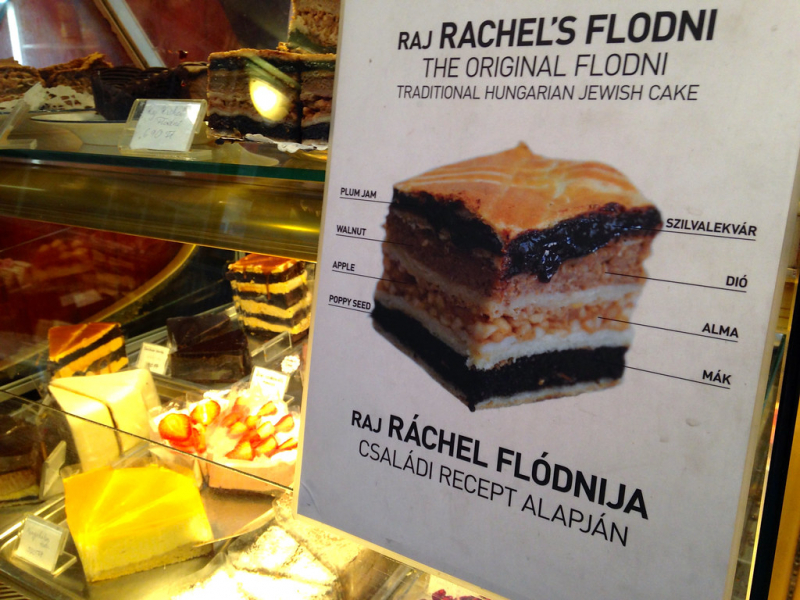
Screenshot of https://www.flickr.com/photos/wordridden/26692455186 Video by Love Food -
Uborkasaláta, a traditional Hungarian cucumber salad, has a history deeply rooted in the country's culinary traditions. The salad's development can be traced back to Hungary's agricultural heritage, where cucumbers were a readily available and popular ingredient.
The origin of Uborkasaláta dates to the late 19th and early 20th centuries, when Hungary was part of the Austro-Hungarian Empire. Cucumbers, a versatile and abundant crop in Hungarian gardens, were frequently used in various dishes. Cucumber salads, like Uborkasaláta, became a common accompaniment to meals. The basic ingredients of Uborkasaláta typically include thinly sliced cucumbers, onions, and fresh dill.
Over time, different regional variations of Uborkasaláta emerged. Some versions add paprika, garlic, or even a hint of lemon juice for added depth of flavor. As Hungarian cuisine evolved, Uborkasaláta became a staple in both everyday and celebratory meals, especially during the summer when cucumbers are in abundance.
Uborkasaláta is a beloved side dish in Hungary and is often served alongside traditional dishes such as goulash, schnitzel, and stuffed peppers. Its fresh and cooling qualities make it a popular choice during warm weather. Uborkasaláta represents the enduring appeal of simple, farm-fresh ingredients and their integral role in Hungarian gastronomy.
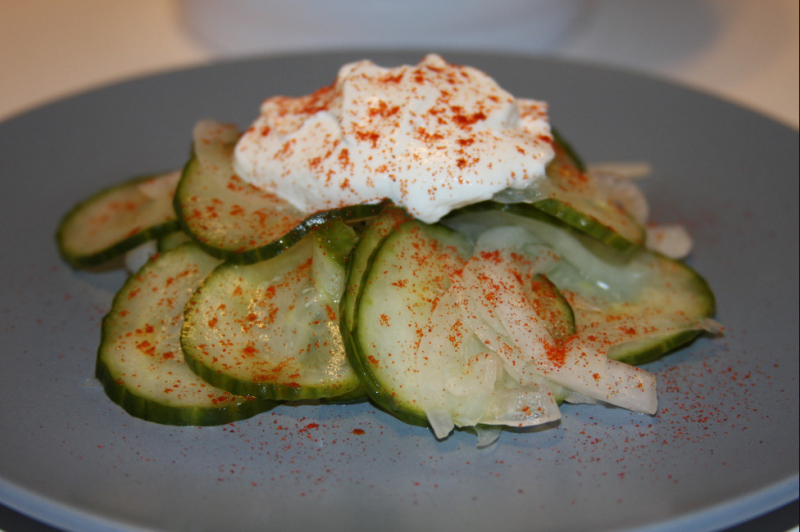
Screenshot of https://ohmygoodygoodness.files.wordpress.com/2011/10/uborska-salta.jpg Video by Andrew Polony -
Lapcsánka, a traditional Hungarian dish, has a history closely tied to the country's culinary heritage. It is a hearty and rustic dish that has evolved over time to become a beloved part of Hungarian cuisine. Lapcsánka's origins can be traced back to Hungary's historical influences, particularly the Ottoman Empire's occupation during the 16th and 17th centuries. During this time, the Ottomans introduced various foods and cooking techniques to Hungary, leaving a lasting impact on the country's culinary traditions.
The dish itself consists of wide, flat noodles made from a simple dough of flour and water. These noodles are traditionally hand-rolled and cut, giving them their distinct shape and texture. The name "lapcsánka" is thought to be derived from the Turkish word "pasa," meaning a pasha or an Ottoman noble, suggesting the dish's Turkish influence.
Lapcsánka is typically prepared by boiling the noodles and then tossing them with a flavorful sauce, often made from ingredients like bacon, onions, and paprika. Variations of Lapcsánka may include additional ingredients such as sour cream, mushrooms, or even sausage, adding depth and richness to the dish. Over the years, Lapcsánka has evolved to accommodate various regional and personal preferences.
Today, Lapcsánka is a comforting and filling dish enjoyed by Hungarians and appreciated by those who seek traditional and satisfying Eastern European cuisine. It serves as a reminder of Hungary's historical connections with other cultures and their lasting impact on the nation's culinary traditions.

Screenshot of https://commons.wikimedia.org/wiki/File:Lapcs%C3%A1nka.jpg Video by Annuskám -
Hortobágyi palacsinta is a delectable Hungarian dish known for its unique combination of flavors and textures. It is essentially a savory pancake, filled with a rich and hearty mixture and then topped with a savory sauce. Hortobágyi palacsinta starts with a thin, crepe-like pancake as its base.
The signature filling for Hortobágyi palacsinta consists of tender, seasoned pieces of meat, often a combination of chicken and veal, mixed with onions, garlic, and various spices. This mixture is cooked until tender meat is infused with deep flavors. To add another layer of indulgence, the filled pancake is generously topped with a rich and creamy sauce, typically made with sour cream and paprika.
Hungarian paprika is a fundamental ingredient in Hortobágyi palacsinta. It flavors the meat filling and is a key sauce component. The paprika provides a smoky, slightly spicy note characteristic of Hungarian cuisine. The dish is often presented with a drizzle of additional paprika and finely chopped parsley on top.
The combination of the tender meat filling, savory sauce, and delicate pancake creates a harmonious blend of flavors. The earthy paprika and the creamy sauce contrast beautifully with the slightly crispy texture of the pancake. Hortobágyi palacsinta is a beloved Hungarian classic that combines the heartiness of a savory filling with the elegance of a thin pancake and a rich, flavorful sauce.
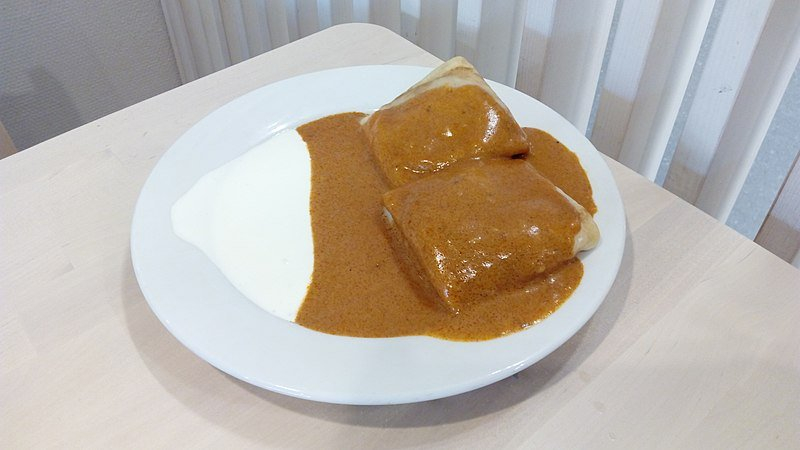
Screenshot of https://commons.wikimedia.org/wiki/File:Hortob%C3%A1gyi_palacsinta,_3.jpg Video by Chef Tamas Noll -
The last item on the list of the 12 Best Street Food in Budapest is Rakott Krumpli. This beloved Hungarian dish is a comforting and hearty potato casserole with a rich history in Hungarian cuisine. This dish, often called "layered potatoes," is a staple in Hungarian homes and a popular choice for gatherings and celebrations.
The key ingredients in Rakott Krumpli typically include potatoes, hard-boiled eggs, sausage or bacon, and sour cream, creating a flavorful and satisfying combination. These potatoes are often parboiled or partially cooked before being layered in a baking dish. Slices of sausage or bacon are often added between the layers of potatoes, providing a savory and smoky flavor.
A generous amount of sour cream is spread over each layer, ensuring the creaminess and tangy taste of the casserole. For added depth and warmth, the dish is seasoned with salt, black pepper, and sometimes Hungarian paprika. Once the layers are assembled in a baking dish, the Rakott Krumpli is baked until the top is golden and the flavors meld together.
Rakott Krumpli is a versatile dish with numerous variations to suit individual tastes. Some versions include cheese, onions, or a touch of paprika for added flavor. It is often a main course but can also be a side dish at family gatherings, holidays, and other special occasions.

Screenshot of https://www.flickr.com/photos/z_b/2099867914 Video by Kitchen Paprikash















